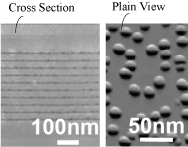Similar to ion-doped solids, semiconductors can also be
cooled by lasers, if a laser photon is absorbed followed by
emission of a higher-energy fluorescence photon (shown
schematically in the figure). Semiconductors have the
potential to be cooled by lasers to below 50 K starting from
room temperature, making this cooling technique promising in
a lot of important applications such as cooling sensors.
However, due to a few obstacles to be overcome (for example,
fluorescence trapping and nonradiative recombination), no
laser cooling of semiconductors has been achieved yet. The
goal of this project will be to develop an understanding of
the cooling physics and find solutions to these challenges,
including new structures and materials. Molecular dynamics
is an excellent tool for investigating the phonon behavior.
Electronic structure calculations will provide information
on energy spectra and transition properties. The photon
transport will be treated using the electromagnetic wave
theory. The results of all of these will be
used in Fermi's Golden Rule calculation, to study the
photon-electron-phonon interactions and predict the cooling
capability. The proposed structure will then be fabricated
and tested, to verify the predicted cooling effect.
 Nanosized
lasing structures include quantum well, quantum wire,
quantum dot, as well as the emerging nanopowders and
nanoceramics. Nanolasers have the potential to be integrated
into circuits, and have attracted great interest. Thermal
management has presented serious challenges in both reducing
the heat generation and enhancing the heat transfer, and
little has been done to integrate these two aspects into a
coupled problem. For a quantum dot laser shown in the
figure, the heat generation is caused by the electron
nonradiative recombination in the dots. It is an
electron-phonon coupling process and can be treated using
the Fermi's Golden Rule. The heat transfer in this small
device should take into account the size and interface
effects, by employing molecular dynamics and the Boltzmann
transport equation. The distributions of the heat generation
and temperature are dependent on each other and can be
solved simultaneously in this way. Criteria for optimum
design, in terms of material and Nanosized
lasing structures include quantum well, quantum wire,
quantum dot, as well as the emerging nanopowders and
nanoceramics. Nanolasers have the potential to be integrated
into circuits, and have attracted great interest. Thermal
management has presented serious challenges in both reducing
the heat generation and enhancing the heat transfer, and
little has been done to integrate these two aspects into a
coupled problem. For a quantum dot laser shown in the
figure, the heat generation is caused by the electron
nonradiative recombination in the dots. It is an
electron-phonon coupling process and can be treated using
the Fermi's Golden Rule. The heat transfer in this small
device should take into account the size and interface
effects, by employing molecular dynamics and the Boltzmann
transport equation. The distributions of the heat generation
and temperature are dependent on each other and can be
solved simultaneously in this way. Criteria for optimum
design, in terms of material and
structure, will be developed.
|